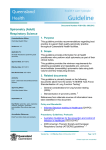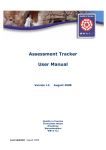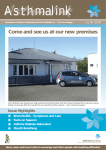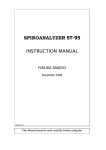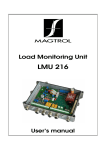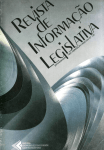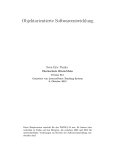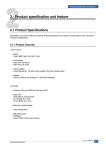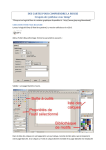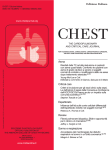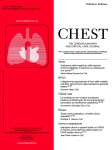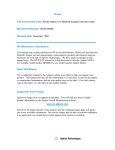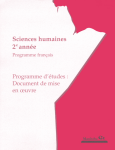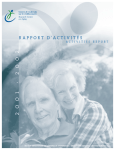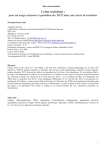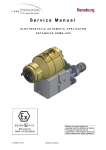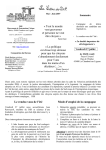Download Spirometry (Paediatric) Guideline
Transcript
Document Number # QH-GDL-393:2013 Spirometry (Paediatric) Respiratory Science Custodian/Review Officer: Chief Allied Health Officer Version no: 1.0 Applicable To: All Health Practitioners performing paediatric spirometry Approval Date: DD/MM/YYYY Effective Date: 26/11/2012 Next Review Date: 26/11/2013 Authority: 1. Purpose This guideline provides recommendations regarding best practice to support high quality paediatric spirometry practice throughout Queensland Health facilities. 2. Scope This guideline provides information for all health practitioners who perform paediatric spirometry as part of their clinical duties. It covers the age-range from preschoolers (children 2 to 6 years of age 1) to young adults (18 years of age). This guideline provides the minimum mandatory requirements for obtaining acceptable and repeatable preand post-bronchodilator (reversibility) spirometric data using both volume and flow–measuring devices. Chair – State-wide Clinical Measurements Network This document emphasises the differences when testing children. Approving Officer 3. Related documents Chief Allied Health Officer This guideline is primarily based on the following documents: Supersedes: New document Key Words: spirometry, spiro, respiratory, measure, spirogram, spirometric, bronchodilator, flow-volume loop, peak flow Accreditation References: EQuIP and other criteria and standards Beydon, N., S. D. Davis, et al. (2007). An official American Thoracic Society/European Respiratory Society statement: pulmonary function testing in preschool children. American Journal of Respiratory & Critical Care Medicine 175(12): 1304-1345. 1 Miller, M. R., J. Hankinson, et al. (2005). Standardisation of spirometry. European Respiratory Journal 26(2): 319-338. 2 References from alternate sources of information have been identified in this document. Version No.: 1.0; Effective From: 26 November 2012 Page 1 of 36 Printed copies are uncontrolled Queensland Health: Spirometry (Paediatric) Policy and Standard/s: Informed Decision-making in Healthcare (QH-POL-346:2011) 3 Procedures, Guidelines, Protocols Australian Guidelines for the prevention and control of infection in healthcare (CD33:2010) 4 2005 American Thoracic Society and European Respiratory Society (ATS/ERS) guidelines 2, 5 Queensland Health Guideline: Spirometry (Adult) 6 Forms and templates Nil 4. Guideline for performing paediatric spirometry 4.1. Emergency Protocol Follow relevant Hospital and Health Service protocols or procedures in the event of an emergency. 4.2. Infection Control Procedures Testing patients with confirmed or suspected communicable diseases may pose a risk to staff and other patients due to potential cross-infection. See Appendix 1 for detailed infection control procedures. Adhere to relevant Hospital and Health Service infection control protocols or procedures at all times and in all facets of spirometry testing. Specific infection control procedures pertaining to spirometry testing are outlined in Appendix 1: Infection Control Procedures. Australian Guidelines for the prevention and control of infection in healthcare (CD33:2010) 4 4.3. Gaining Consent Gain consent in accordance with Queensland Health’s Informed Decision-making In Healthcare Policy 3. 4.4. Identifying Indications and Contraindications for performing spirometry 7 Indications for performing spirometry 7 Spirometry has a variety of uses including: assisting with diagnostic evaluations monitoring of pulmonary function evaluating disability or impairment Version No.: 1.0; Effective from: 26 November 2012 Page 2 of 36 Printed copies are uncontrolled Queensland Health: Spirometry (Paediatric) providing public health information. For further indications refer to Appendix 2: Purposes for performing spirometry. Contraindications for performing spirometry 7 Some conditions may pose a relative danger to a patient or affect the validity of spirometry performance and results. These include, but are not limited to the following: unstable cardiovascular status, unstable angina, recent myocardial infarction (within one month), or pulmonary embolism haemoptysis of unknown origin recent pneumothorax thoracic, abdominal, or cerebral aneurysms recent thoracic, abdominal or eye surgery acute disorders such as nausea or vomiting severe respiratory distress physical limitations cognitive impairment, dementia inability to adequately understand and follow instructions (except when familiarising child with spirometry) 1. 4.5. Facilities and equipment Testing Facilities Ensure clearly defined rooms are available for spirometry testing, particularly for patients with confirmed or suspected communicable diseases, and immunocompromised patients. Specific infection control procedures pertaining to spirometry testing are outlined in Appendix 1: Infection Control Procedures. A child friendly pulmonary function laboratory is of the utmost importance. Young children need to feel comfortable in the laboratory environment if they are to perform the measurements accurately. Designated paediatric rooms may help to prevent distraction in children during testing. The operator has a significant impact on the comfort level of the child 1. This type of environment may be achieved through a combination of friendly conversation, songs, or through distraction with a videotape, book, interactive computer game, toy or puzzle. Allow adequate space for chairs, wheel-chairs, and prams for the child and accompanying adult(s). Version No.: 1.0; Effective from: 26 November 2012 Page 3 of 36 Printed copies are uncontrolled Queensland Health: Spirometry (Paediatric) Spirometer There are two general types of spirometers: volume-displacement and flow-sensing spirometers (see Appendix 3: General description of volume- and flow-sensing spirometers for details). When purchasing spirometers, ensure that: o the spirometers meet the minimum ATS/ERS recommendations 2 o the spirometers are capable of accumulating volume for ≥ 15s and measuring volumes ≥ 8L (BTPS) with an accuracy of ± 3% of reading or ±0.050L (whichever is greater) with flows between 0 and 14 L.s-1 o the total resistance to air flow at 14 L.s-1 is <1.5cmH20L-1 (0.15kPa.L-1.s-1). Note: For more detailed requirements refer to the ATS/ERS guidelines 2. Ensure spirometers meet the minimum ATS/ERS recommendations 2. Ensure the spirometer’s graphic display permits visual inspection of the flow–volume and volume–time curves essential for quality control. Preschool children are more likely to produce technically inadequate expirations than older children, and are likely to become bored or tired if the test session is prolonged unnecessarily. It is therefore advantageous if the operator is able to visualize these curves onscreen, or at least before the next effort. Set the display to include FVC, FEVt, time to PEF (PEFT), VBE (back-extrapolation volume) and the point at which flow ceases, presented as a proportion of PEF. Timed volumes displayed should include FEV0.5 or FEV0.75 and FEV1. This is because in preschoolers FEV1 often approximates the FVC. Review these measurements before the next effort, and encourage the child to alter his or her technique if necessary 1. Paediatric spirometry equipment may include animated incentives in software intended for both pre-schoolers and older children. These incentives are designed to encourage rapid and prolonged expiration1. Incentives that encourage tidal breathing and maximal inspiration may also be helpful. Use these visual incentives discretionally as they may distract some children. Spirometers for use in preschool patients must be capable of measuring instantaneous flows with an accuracy of at least ± 5% 1. Dead space should be minimized where possible, although this requirement does not preclude the use of bacterial filters. Otherwise, recommendations for equipment for use in adult subjects apply 1. Other supplies: Assemble the following supplies: disposable/reusable supplies: mouthpieces, nose clips, flow sensors (pneumotachometers) infection control supplies: disposable in-line bacteria filters, gloves, gowns, masks, protective eyewear Version No.: 1.0; Effective from: 26 November 2012 Page 4 of 36 Printed copies are uncontrolled Queensland Health: Spirometry (Paediatric) stadiometer for measuring height, scales for weight, tape measure for arm span, and Harpenden Callipers for measurement of ulna length when standing height cannot be measured (see Appendix 6: Measurement of Ulna Length) paediatric chairs computer/recorder supplies (depending on the type of spirometer used) barometer, thermometer and hygrometer, if not integrated into the equipment used. This equipment is used for correcting volumes to body temperature (i.e.37oC), ambient pressure, air saturated with water vapour (BTPS) validated 3L-volume calibration syringe for reversibility test: metered dose inhaler (MDI) and spacer, or small volume nebuliser with compressed gas source and disposable nebuliser mask/ mouthpiece. 4.6. Training requirements All health professionals performing spirometry should as a minimum complete the Queensland Health Spirometry Training Program or another spirometry training to an equivalent standard 8. In addition, when performing spirometry on a child, a Blue Card is required by staff whoare not Registered Health Practitioners. For further clarification on specific requirements see the Commission for Children and Young People and Child Guardian website (www.ccypcg.qld.gov.au). For spirometry testing in preschool children, it is essential that the health practitioner has the ability to establish rapport with the child, and that he or she is able to obtain measurements without causing distress 1. 4.7. Test Procedure 4.7.1. Key measures and terminology Abbreviation Term Definition/Explanation/Details VC Vital capacity, litres (L) The volume change between the position of full inspiration and complete expiration 9 FVC Forced vital capacity, litres (L) The maximal volume of air exhaled with maximally forced effort from a position of maximal inspiration 5 FEV1 Forced expiratory volume in one second, litres (L) The maximal volume of air exhaled in the first second of a forced expiration from a position of full inspiration 2 PEF Peak expiratory flow litres per second (L.s-1) or litres per minute (L.min-1) The maximum expiratory flow achieved from a maximum forced expiration, starting without hesitation from a point of maximal lung inflation 2 BPTS Body pressure and temperature (saturated) Body temperature (i.e.37oC), ambient pressure, saturated with water vapour 5 Version No.: 1.0; Effective from: 26 November 2012 Page 5 of 36 Printed copies are uncontrolled Queensland Health: Spirometry (Paediatric) Standard units L L.s Litres -1 L.min Litres per second -1 Litres per minute 4.7.2. Preparing equipment and ensuring quality control See Appendix 4: Quality Control Procedures. Preparing a spirometer: (as outlined in the ATS Pulmonary Function Laboratory Management Manual 9) Assemble the components according to the manufacturer’s instructions (i.e. tubing, connectors, flow-sensors, valves and adapters). Put in place a new in-line bacterial filter (if used), disposable mouthpiece or disinfected reusable mouthpiece for each patient. Turn on the system to ensure adequate warm up (refer to manufacturer’s guidelines). Allow time for equilibration to room temperature for portable systems. Perform a validation check (calibration check) (For detailed procedures on performing validation and calibration see Appendix 4: Quality Control Procedures). Only perform spirometry at temperatures recommended by the equipment manufacturers. Document the environmental data from an accurate source representative of the laboratory prior to calibration. Note: Environmental data includes internal spirometer temperature or ambient temperature, relative humidity (if applicable) and barometric pressure. Check for leaks daily when using volume-displacement spirometers. Leaks can be detected by applying constant pressure ≥3.0 cmH20 (0.3kPa) with the spirometer outlet occluded (at or including the mouthpiece). A volume loss of >30ml after 1 min indicates a leak and needs correcting. Refer to manufacturer’s guidelines if a problem is detected. Check the flow-sensors for holes, clogging, channel plugging, or excess moisture daily. Refer to manufacturer’s guidelines if a problem is detected. Validating the calibration of the spirometer: A validation is the procedure used to check that the device is within calibration limits (e.g. ±3% of true). Conduct daily validation checks according to manufacturer’s instructions (see Appendix 4: Quality Control for details). 2 Note: More frequent checks may be required where there is high patient throughput. 2 Version No.: 1.0; Effective from: 26 November 2012 Page 6 of 36 Printed copies are uncontrolled Queensland Health: Spirometry (Paediatric) 4.7.3. Preparing the patient Carry out infection control measures prior to testing, particularly hand washing for both patient and personnel performing spirometry. Document if the patient has withheld bronchodilator medications prior to testing. Note: The use of bronchodilator medications is at the patient’s discretion despite the recommendation to withhold before the test. Refer to section 4.7.6 Assessing Bronchodilator Reversibility for detailed instructions regarding withholding times. Confirm that the patient has 5: — ceased smoking at least 1hr before testing — ceased alcohol consumption at least 4 hrs before testing — refrained from performing vigorous exercise within 30min of testing — refrained from eating a large meal within 2hrs of testing. Ensure the patient is wearing clothing that enables full chest and abdominal expansion (if possible loosen clothing). Assess patient for physical and developmental status to determine their ability to perform the test and/or if special arrangements are required e.g. if the patient has a tracheostomy. Engage an interpreter if required as per Queensland Health Language Services Policy10. Record relevant medical history that may assist in the interpretation/reporting of the spirometry. This may include the following. — Breathlessness — Cough — Sputum — Wheeze — Symptoms of asthma — Smoking history (years, packs/day, current status) — Known lung disease/chest injuries/operations — Work history — Occupational exposure to dust and respiratory irritants Record the type, dosage and time taken of any inhaled or oral medication that may alter lung function. Measure and record the patient’s height (barefoot) in centimetres (cm) to one decimal place, with feet together, heels against the wall, standing as tall and straight as possible and with the head in the Frankfort horizontal plane 11 (eyes level and looking ahead; for detailed explanation see Appendix 5: Measurement of Stature). Measure the Version No.: 1.0; Effective from: 26 November 2012 Page 7 of 36 Printed copies are uncontrolled Queensland Health: Spirometry (Paediatric) patient’s height using an accurate measuring device, such as a stadiometer. Gently apply lifting pressure to the mastoid processes, to elongate the vertebral column. Height shall be measured and recorded at each visit using an accurate measuring device, such as a stadiometer. When patients are unable to stand or accurate height measurements are impeded by deformity (e.g. scoliosis) then the ulna length should be measured using Harpenden callipers and the ulna length used in pulmonary function prediction equations 12. Refer to Appendix 6: Measurement of ulna length, for further instruction. If the measure of ulna length is not possible then the measurement of arm span can be used as it closely approximates standing height in children 13. Have the patient stretch their arms in opposite directions to attain the maximal distance between the tips of the middle fingers. Measure the patient’s weight in kilograms (kg) to the nearest 0.1kg with indoor clothing and without shoes. Verify the patient’s identity (full name and date of birth) and the procedure to be performed. Document the patient’s ethnic origin, gender, date of birth and hospital identification (UR) number. Leave the patient’s dentures in place unless they interfere with the testing procedure or the patient’s ability to perform the procedure as required 2. For safety reasons perform the test with the patient sitting comfortably in a chair with arms and without wheels. Request the patient to sit upright, legs uncrossed and both feet on the floor 5, 7 _ENREF_7. To achieve this posture, it is suggested that paediatric chairs are used. If standing is preferred when performing the spirometry test, then document the standing position in the report. Clearly instruct the child in the procedure prior to the commencement of each test and ensure they understand all requirements of the test. Give ample opportunity for the patient or care giver to ask questions or receive clarification on the test and its requirements. Actively coach the child before and during each trial. Young children may not fully understand the requirements for the test but should be encouraged enthusiastically. 4.7.4. Performing test procedure The test procedure below is as stated in the Queensland Health Guideline: Spirometry (Adult) 6 with the following exceptions: Note: The Vital Capacity (VC) manoeuvre is not usually performed Correct posture with head slightly elevated for older children and in the neutral position for younger children. Version No.: 1.0; Effective from: 26 November 2012 Page 8 of 36 Printed copies are uncontrolled Queensland Health: Spirometry (Paediatric) Note: There are two methods for testing spirometry: Open-circuit and Closed- circuit. In the open-circuit method the patient approaches the mouth piece after a complete inhalation to total lung capacity (TLC), whereas in the closed circuit method the patient inhales to TLC whilst firmly on the mouth piece and after several tidal volume (TV) breaths on the mouthpiece. Both methods are described below. 1. Perform validation of the machine (see Appendix 4: Quality Control Procedures for details). 2. Introduce yourself to the patient, including your name and position title and establish rapport. 3. Verify the following information: — check for completed and signed doctor’s request form, including indications and contraindications — identify patient by name, date of birth and hospital identification number — check for any contraindications to spirometry testing (see section 4.4 Indications and Contraindications for performing spirometry) — record current medication that may alter lung function and a brief history (as outlined in section 4.7.6 Assessing bronchodilator reversibility — record height (cm) and weight (kg) measurements — record gender and ethnic origin — record testing position if not sitting and justification why test is performed in a nonsitting position. Performing the FVC and FEV1 manoeuvre 4. Explain and demonstrate the test manoeuvre to the patient, including: — Correct use of the mouthpiece and nose clip — Correct posture with head slightly elevated — Position of the mouthpiece, including tight mouth seal over the mouthpiece. — Complete inhalation prior to FVC and FEV1 — Rapid and complete exhalation with maximal force for FVC and FEV 1. 5. Have the patient assume the correct sitting position i.e. upright posture, legs uncrossed and both feet flat on the floor. 6. Activate the spirometer. a) When using the open circuit method: — Attach the nose clip and instruct patient to inhale completely and rapidly until their lungs are full, place mouthpiece in mouth and close lips tightly around the mouthpiece while holding their lungs full Version No.: 1.0; Effective from: 26 November 2012 Page 9 of 36 Printed copies are uncontrolled Queensland Health: Spirometry (Paediatric) — Instruct patient to exhale forcefully until no more air can be expelled. b) When using the closed circuit method: — Attach nose clip, place mouthpiece in mouth (or assist patient in positioning themselves on the mouthpiece) and instruct patient to close lips tightly around the mouthpiece and breathe quietly for no more than 5 breaths (i.e. relaxed, ‘normal’ tidal breathing) — Instruct patient to inhale completely and rapidly until their lungs are full — With little or no pause at TLC (<1sec), instruct patient to exhale forcefully until no more air can be expired. 7. Encourage the patient to maintain an upright posture (i.e. no bending forwards) during the manoeuvre. 8. If a flow-volume “loop” is being performed (to measure forced inspiratory vital capacity) the patient will exhale rapidly and forcefully until end of test criteria are achieved, and then inhale as rapidly as possible back to TLC. 9. Observe the patient at all times during the manoeuvre in case they become unsteady due to light-headedness or experience other adverse reactions, such as chest pain. 10. Terminate the manoeuvre (using keyboard, mouse or special function keys as specified by the manufacturer) once the end of test criteria has been met (see section 4.7.5 Determining acceptability and repeatability). 11. Repeat the instructions and manoeuvres for a minimum of three manoeuvres, more if necessary, coaching vigorously until end of test criteria are met; no more than eight manoeuvres are usually required, however, more than 8 attempts are permitted with pre-school children 1. 12. Terminate the test once the acceptability and repeatability criteria have been met (see section 4.7.5 Determining acceptability and repeatability). Performing the VC testing 1. Explain and demonstrate the test manoeuvre to the patient, including: a) Correct use of the mouthpiece and nose clip b) Position of the mouthpiece, including tight mouth seal over the mouthpiece c) Correct posture with head slightly elevated d) Slow, complete and relatively constant flow inhalation for VC e) Slow, complete and relatively constant flow exhalation for VC f) Emphasis on complete filling and emptying of the lungs. Note: If requested by the medical officer, it is recommended that the VC is performed before the FVC because of the potential for muscular fatigue and volume history effects 2. 2. Have the patient assume correct posture and attach nose clip. 3. Activate the spirometer. Version No.: 1.0; Effective from: 26 November 2012 Page 10 of 36 Printed copies are uncontrolled Queensland Health: Spirometry (Paediatric) a) When using the open circuit method: — Instruct the patient to inhale completely and rapidly until their lungs are full, place the mouthpiece in the mouth and close lips tightly around the mouthpiece while holding their lungs full — Instruct patient to exhale slowly and completely until their lungs are empty. b) When using the closed circuit method: — Attach nose clip, place mouthpiece in mouth (or assist patient in positioning themselves on the mouthpiece) and instruct patient to close lips tightly around the mouthpiece and breathe quietly for no more than five breaths (i.e. relaxed, ‘normal’ tidal breathing) — Instruct the patient to inhale completely until their lungs are full and exhale slowly and completely until their lungs are empty. This provides a measure of expiratory vital capacity (EVC) — Alternatively, instruct the patient to exhale completely from end-inspiration on a tidal breath until their lungs are empty. This provides a measure of inspiratory vital capacity (IVC). 4. Encourage the patient to “keep going” until there is no volume change observed (see section 4.7.5 Determining acceptability and repeatability). 5. Observe the patient at all times during the manoeuvre in case they experience lightheadedness or any other adverse reactions. 6. Terminate the manoeuvre (using keyboard, mouse or special function keys as specified by the manufacturer) once the end of test criteria have been met (see section 4.7.5 Determining acceptability and repeatability). 7. Repeat instructions and manoeuvres for a minimum of three manoeuvres coaching vigorously until end of test criteria are met; with a maximum of four attempts and a rest period of >1 minute between each manoeuvre. 8. Terminate test once acceptability and repeatability criteria are met (see section 4.7.5 Determining acceptability and repeatability). 4.7.5. Determining acceptability and repeatability of FEV1, FVC and VC measurements Clinically useful spirograms must be acceptable (i.e meet the criteria that comprises a good quality manoeuvre) and repeatable (i.e the two highest FEV 1, FVC and VC from three acceptable manoeuvres are in close agreement). A spirogram is “acceptable” if the following are met: Start of Test Criteria begins from full inspiration has a rapid start of test, that is, the back extrapolated volume (VBE) is <5% of FVC or 0.15L, whichever is greater (see Appendix 8: Determination of back-extrapolation Version No.: 1.0; Effective from: 26 November 2012 Page 11 of 36 Printed copies are uncontrolled Queensland Health: Spirometry (Paediatric) volume). If the manoeuvre has an obviously hesitant start then the trial should be terminated early to avoid unnecessary prolonged effort. for preschool children, if the VBE is greater than 80 ml, or 10% to 12.5% of FVC then the curve should be reinspected, but need not necessarily be excluded 1. 14 , the time to reach the peak expiratory flow (PEFT) in the flow-volume curve is <0.16sec for children and adolescents 15 and < 0.120sec to 0.130sec for pre-school children (3-5 year olds) 14, 16 Middle of Test Criteria No obstruction, hesitation or artefact impeding the blow (see Appendix 7: Examples of volume-time and flow-volume spirograms) including: a. Cough during the first second of exhalation b. Glottic closure that influences the measurement c. Early termination or cut-off d. Effort that is not maximal throughout e. Air leaks at mouth f. Obstructed mouthpiece (due to tongue or teeth in front of the mouthpiece, or mouthpiece deformation due to biting). End of Test Criteria Continuous maximal expiratory blow for ≥6 sec in duration for children older than 10 years, and ≥3 sec for children less than 10 years; A plateau in the volume-time curve (i.e. no change in volume (<0.025L) for a 1 second period) Note: A plateau is defined as no volume change (<0.025L) for a 1 second period. In preschool aged children, if expiratory flow stops at greater than 10% of the peak flow (PEF), then the manoeuvre should be classified as showing premature termination The patient cannot or should not continue to exhale 2. How to ensure repeatability between individual spirograms After three acceptable spirograms have been obtained, the following checks are used to assess for repeatability: The two largest values of FVC or VC must be within 0.150L of each other The two largest values of FEV1 must be within 0.150L of each other For patients with an FVC of ≤1.0L and preschool aged children the two largest FVC and FEVt values are within 0.100L of each other or 10% of the highest value 1. A minimum of three acceptable manoeuvres should be saved and utilised for analysis/interpretation. Version No.: 1.0; Effective from: 26 November 2012 Page 12 of 36 Printed copies are uncontrolled Queensland Health: Spirometry (Paediatric) If between-manoeuvre criteria are not achieved, report results with explanatory comments. Peak expiratory flow (PEF) During spirometry testing PEF is measured in conjunction with FEV1 and FVC and can be used to indicate maximal patient effort. Note: PEF can also be measured independently using a Peak Flow Meter. Refer to ATS/ERS guidelines (2005) 2. 4.7.6. Assessing bronchodilator reversibility 2 Assessing bronchodilator reversibility is often performed as part of Spirometry. The choice of drug, dose and mode of delivery is a clinical decision made by the medical officer requesting the test, and dependent on the clinical question and clinical judgement. Note: The reversibility test procedure below is as stated in the Queensland Health Guideline: Spirometry (Adult) 6 with the following exceptions: Administer the salbutamol (Ventolin) using metered dose inhalation of 400-600ug salbutamol (4-6x100ug metered doses at 30 second intervals) via a valved spacer device 1 Shake the metered dose inhalers before each actuation. Recommendation for administration of bronchodilators in children is as follows: for young children: via the tidal “normal” breathing method of 5 breathes for every actuation for school age children: via the breathe-hold method of 5 -10 seconds breath-hold following the actuation from the start of a rapid inhalation. Patient Preparation Bronchodilator medications should be withheld prior to testing if evidence of the presence or absence of reversible airflow limitation is required. Short-acting bronchodilators (β-agonists or anticholinergics) should be withheld for 4 hrs. — Long-acting β-agonist bronchodilators, oral therapy with Aminophylline or slow release β-agonist should be withheld for 12hrs. — If the aim of the test is to determine whether the patient’s lung function can be improved with therapy in addition to their regular treatment, then regular medication as prescribed can be continued 5. All other preparation steps are outlined in section 4.7.3 Preparing the patient. Version No.: 1.0; Effective from: 26 November 2012 Page 13 of 36 Printed copies are uncontrolled Queensland Health: Spirometry (Paediatric) Administration of Bronchodilators Regardless of which method is used, consideration of pulmonary deposition characteristics of the devices must be made so that appropriate and standardised dosages are delivered 2. Consult local Hospital and Health Service standing orders for bronchodilator administration for further guidelines. Test Procedure Perform spirometry according to 4.7.4 Performing Test Procedure. This will provide a ‘pre-bronchodilator’ result. Administer the bronchodilator medication in the dose and method indicated for the test and according to hospital guidelines. Perform spirometry according to section 4.7.4 Performing Test Procedure 10 to 15 minutes following administration for short-acting β-agonists, and 30 minutes for short acting anti-cholinergic agents 2. This will provide the ‘post-bronchodilator’ result. Acceptability and repeatability 2 Ensure test acceptability and repeatability according to section 4.7.5 Determining acceptability and repeatability. Interpretation of results The interpretation of reversibility in children is subjective. The medical officer may look at the shape of the flow-volume curve combined with the magnitude of improvement of FEVt. An increase ≥12% in FEVt is usually taken as positive, however this criteria is not well defined in pre-school children 1. 4.7.7. Reporting results Note: Reporting results as outlined below is as stated in the Queensland Health Guideline: Spirometry (Adult) 6 with the following exception: In addition to the below information, if FEV0.5 or FEV0.75 are measured then report the highest values from the acceptable trials 1. Note: Test results that do not meet acceptability and repeatability criteria may still provide useful clinical information. It is important to make note of the reasons in the report, and advise to interpret with care. All volumes and flows are to be reported at BTPS conditions. FEV1 and FVC should be reported in litres (L) to two decimal places. Peak flow should be reported in litres per second (L.s-1) to two decimal places or in litres per minute (L.min-1) with no decimal places. Version No.: 1.0; Effective from: 26 November 2012 Page 14 of 36 Printed copies are uncontrolled Queensland Health: Spirometry (Paediatric) The largest VC from at least two acceptable and repeatable manoeuvres is reported. The largest FVC and largest FEV1 from acceptable and repeatable manoeuvres are reported, even though the values may not come from the same manoeuvre. All other flows, if required by the requesting medical officer, are reported from the “best” test. The “best” test is defined as the manoeuvre with the largest sum of FVC and FEV1. If a single volume-time tracing or flow-volume curve is to be included in a final report, it should be the spirogram from the effort with the largest sum of FVC and FEV 1. Expiratory and inspiratory flow-volume curves from different acceptable efforts may be combined to produce a flow-volume loop. A medical officer may request the reporting of other measurements (see section 5 Definition of Terms), in which case the largest value for all these measurements should be reported. The final report should include: — scientist’s comments regarding acceptability and repeatability of the data — software version (if applicable) — date, time and results of most recent calibration — identification of reference values used. 4.8. Note: Test results that do not meet acceptability and repeatability criteria may still provide useful clinical information. It is important to make note of the reasons in the report, and advise to interpret with care. Quality Control Procedures Quality control procedures specific to spirometry testing are detailed in Appendix 4: Quality Control Procedures. Daily validation (calibration checks), weekly biological control testing, and data analysis are the minimum quality control requirements. 5. Definition of Terms Definitions of key terms are provided below. Abbreviation Term Definition / Explanation / Details VC Vital capacity, litres (L) The volume change between the position of full inspiration and complete expiration 9 IVC Inspiratory vital capacity, litres (L) The maximal volume of air inhaled slowly from the point of maximal exhalation achieved by a slow expiration from end-tidal inspiration 9 EVC Expiratory vital capacity, litres (L) The maximal volume of air exhaled slowly from the point of maximal inhalation 9 FVC Forced vital capacity, litres The maximal volume of air exhaled with Version No.: 1.0; Effective from: 26 November 2012 Page 15 of 36 Printed copies are uncontrolled Queensland Health: Spirometry (Paediatric) (L) maximally forced effort from a position of maximal inspiration 5 FIVC Forced Inspiratory Vital Capacity, litres (L) The maximal volume of air inhaled with maximally forced effort from a position of maximal expiration 9 FIFx% Forced Inspiratory Flow, litres per second (L.s-1) The flow measured during a forceful inspiration when x% of the FIVC has been inspired 9 FEV1 Forced expiratory volume in one second, litres (L) The maximal volume of air exhaled in the first second of a forced expiration from a position of full inspiration 2 FEVt Forced expiratory volume, litres (L) The maximal volume of air exhaled with maximally forced effort in t seconds; 1 and 6 seconds are the most common 9 FEVt/FVC Forced expiratory volume in t seconds to forced vital or vital capacity ratio The ratio of FEVt to FVC or VC expressed as a percentage (FEV1 is the most commonly used measure) 9 FEFx% Forced expiratory flow litres per second (L.s-1) The flow measured during a forceful expiration when x% of the FVC has been exhaled; FEF25%, FEF50%, and FEF75% are commonly reported 9 FEF25-75% Forced mid-expiratory flow litres per second (L.s-1) The average flow measured over the middle 50% of an FVC manoeuvre 9. Also known as mid expiratory flow 2 PEF Peak expiratory flow litres per second (L.s-1) or litres per minute (L.min-1) The maximum expiratory flow achieved from a maximum forced expiration, starting without hesitation from a point of maximal lung inflation Or FEVt/VC 2 TLC Total lung capacity, litres (L) The volume of gas in the lungs after maximal inspiration, or the sum of all volume compartments 17 TV Tidal volume, litres (L) The volume of gas inhaled or exhaled during the respiratory cycle (also known as VT) 17 BTPS Body temperature and pressure (saturated) Body temperature (i.e.37oC), ambient pressure, air saturated with water vapour 5 Acceptability Criteria Satisfactory start, middle and end of test conditions 5 Repeatability Criteria Closeness of agreement between the results of successive measurements of the same item carried out, subject to all of the following conditions: same method, same observer, Version No.: 1.0; Effective from: 26 November 2012 Page 16 of 36 Printed copies are uncontrolled Queensland Health: Spirometry (Paediatric) same instrument, same location, same conditions of use, and repeated over a short space of time 5 6. Consultation Key stakeholders (position and business area) who reviewed this version are: Respiratory Working Party: o Michael Brown (Director of Respiratory & Sleep Sciences, Royal Brisbane and Women’s Hospital), o Andrew Coates (Chief Respiratory Scientist, Mater Health Services), o Annette Dent (Scientific Director, Respiratory Science, The Prince Charles Hospital), o Janine Ferns (Director Clinical Measurements, Cairns Base Hospital), o Leanne Rodwell (Respiratory Scientist, Royal Children’s Hospital), o Irene Schneider (Respiratory Sciences Clinical Educator, Respiratory Working Party Chair, The Prince Charles Hospital), Jessica Wilson (Respiratory Scientist, Respiratory Working Party Assistant Chair), o Leanne Gauld, Respiratory Paediatrician, Mater Children’s Hospital o Margaret McElrea, Respiratory Scientist, Queensland Children's Respiratory Centre, Royal Children's Hospital Primary stakeholders as identified in the Stakeholder analysis o QH Respiratory Laboratory Clinical Directors o QH Respiratory Laboratory Managers o Paediatric Respiratory Specialists, Children’s Health Services, Queensland o Paediatric Respiratory Specialists, Mater Children’s Hospital, Brisbane o Statewide Respiratory Clinical Network (SRCN) o State-wide Clinical Measurements Network (SWCMN) o Clinical Measurements Advisory Group (CMAG) for Clinical Education and Training. o District Directors of Allied Health o Allied Health Workforce Advice and Coordination Unit (AHWACU) o Allied Health Clinical Education & Training (AHCETU) o Clinical Education Queensland (ClinEdQ) o Australia and New Zealand Society of Respiratory Science (ANZSRS) Queensland Health Respiratory Laboratory Managers: o Chris Brown (Respiratory and Sleep Scientist – Advanced, The Townsville Hospital) o Barry Dean (Respiratory Scientist, Royal Brisbane Children’s Hospital) o Brenton Eckert (Scientific Director, Princess Alexandra Hospital) o Ryan Harle (Respiratory Scientist – Laboratory Manager, Logan Hospital) o Andrew Southwell (Senior Clinical Measurement Scientist Respiratory, Redcliffe/Caboolture) Version No.: 1.0; Effective from: 26 November 2012 Page 17 of 36 Printed copies are uncontrolled Queensland Health: Spirometry (Paediatric) Joanne Wex (Manager- Clinical Measurements, Rockhampton Base Hospital) o Debbie Zagami (Respiratory Scientist-Laboratory Manager, Gold Coast Hospital) o Queensland Health Respiratory Laboratory Clinical Directors: o Scott Bell (Thoracic Program Medical Director, The Prince Charles Hospital) o Anthony Matthiesson (Director Respiratory and Sleep Unit, The Townsville Hospital) o Stephen Morrison (Director of Thoracic Medicine, Royal Brisbane and Women’s Hospital) o Brent Masters (Director, Queensland’s Children’s Respiratory Centre) o Graham Simpson (Director of Thoracic Medicine, Cairns Base Hospital) o David Serisier (Director, Respiratory Medicine, Mater Health Service) o Pathmanathan Sivakumaran (Director, Respiratory Services, Gold Coast Hospital) o Khao Tran (Respiratory Physician, Logan Hospital) o Dr Craig Hukins (Director, Department of Respiratory and Sleep Medicine, Princess Alexandra Hospital) State-wide Respiratory Clinical Network (SRCN) o Deb C. Hill (Network Coordinator, State-wide Respiratory Clinical Network & Principal Project Officer, Clinical Networks Team, Patient Safety & Quality Improvement Service, Centre for Healthcare Improvement) 7. Guideline Revision and Approval History Version No. 1.0 Modified by Amendments authorised by Approved by Dane Enkera - Chair State-wide Clinical Measurements Network Brett Duce - Chair Clinical Measurements Advisory Group (for clinical education) Version No.: 1.0; Effective from: 26 November 2012 Page 18 of 36 Printed copies are uncontrolled Queensland Health: Spirometry (Paediatric) 8. Appendices Appendix 1: Infection Control Procedures The aim of infection control is to provide a better understanding of infections and their modes of transmission to staff. It is also important in maintaining a safe working environment for staff and patients to help prevent disease transmission during pulmonary function testing. General Hygiene guidelines: Poor hygiene practice not only increases patient morbidity but also increases patient mortality. Lung function testing equipment has the ability to spread or transmit blood borne and airborne pathogens (droplets and other particles containing microbes being released in the air) e.g. tuberculosis (TB), chicken pox respiratory syncytial virus (RSV), human immunodeficiency virus (HIV) and hepatitis. The majority of the patient population would not be affected but individuals who are immune-compromised are far more likely to develop complications 4. If an active respiratory infection has been identified in a patient then the test request should be confirmed with the requesting medical officer. Transmission of pathogens 5, 9 : Transmission of pathogens can occur via a number of different routes including: patient staff, staff – patient, patient – patient, staff – staff, patient – equipment and staff – equipment. ATS/ERS guidelines 5 define direct and indirect contact with regards to pulmonary function testing and transmission of pathogens as follows: Direct contact: (From person to person) There is the potential for transmission of upper respiratory disease, enteric infections, and blood-borne infections through direct contact. Although hepatitis and HIV transmission are unlikely via saliva, disease transmission is a possibility when there are open sores on the oral mucosa, bleeding gums, or haemoptysis. The most likely surfaces for contact are mouthpieces and the immediate proximal surfaces of valves or tubing. Indirect contact: (Via animate and inanimate objects) There is potential for transmission of TB, various viral infections, and possibly, opportunistic infections and nosocomial pneumonia through aerosol droplets. The most likely surfaces for possible contamination by this route are mouthpieces and proximal valves and tubing. Version No.: 1.0; Effective from: 26 November 2012 Page 19 of 36 Printed copies are uncontrolled Queensland Health: Spirometry (Paediatric) Prevention and Precautions: Standard precautions should be followed at all times. Disease prevention or cross contamination can be prevented by addressing the following issues regarding the source and the transmission of pathogens: ensuring a clean environment proper hand-washing techniques sterilisation and disinfection of equipment including valves and tubing use of in-line bacterial/viral filters safety mouthpieces personal protective equipment (e.g. gloves, gown, masks etc) isolation of infected patients (Source Isolation) precautions with testing patients with open sores or haemoptysis isolation of susceptible patients (Protective Isolation). Hands should be washed between patients and immediately after direct handling of mouthpieces, tubing, breathing valves or the interior surfaces of equipment. Gloves should be worn at all times when handling contaminated equipment or where surfaces are suspected of holding pathogens which could be potentially transmitted. Gloves also offer another barrier of defence for staff with open cuts or sores which need to be covered to prevent contamination and or transmission of disease pathogens. Volume and flow-based spirometers: Disposable in-line filters are an effective and less expensive method of preventing equipment contamination. In-line filters have been shown to remove microorganisms from the expiratory air stream and thus prevent their deposition as aerosol nuclei on spirometer surfaces. The use of in-line filters does not eliminate the need for regular cleaning and decontamination of lung function equipment. When using equipment with inspiratory and expiratory manoeuvres, in-line bacterial/ viral filters should be used and disposed of after every patient (single patient use). Closed circuit A volume based spirometer in which a closed circuit technique has been used should be flushed between subjects with room air at least five times over the entire volume range of the spirometer to enhance clearance of droplet nuclei. The breathing tube or mouthpiece should be decontaminated or changed between patients. Open circuit If the patient or subject only exhales into the spirometer, only the portion of the circuit through which re-breathing occurs must be decontaminated between patients. Alternatively a disposable sensor may be used and decontamination of sensors and mouthpieces can be avoided. A low resistance disposable one-way valve mouthpiece may be used to prevent inhalation from an open circuit. This mouthpiece needs to be disposed of between patients. Version No.: 1.0; Effective from: 26 November 2012 Page 20 of 36 Printed copies are uncontrolled Queensland Health: Spirometry (Paediatric) Common transmissible infectious diseases often seen in the Respiratory Laboratory include: Hepatitis B Hepatitis C Tuberculosis (TB) Human Immunodeficiency Virus (HIV) Pseudomonas cepacia Cytomegalovirus (CMV) Varicella Zoster Virus (VZV). The ATS/ERS 5 recommends extra precautions are taken for patients with known transmissible infectious diseases. Reserve equipment for the sole purpose of testing infected patients. Test infected patients at the end of the day, allowing time for the equipment to be disassembled and disinfected. Test patients in their own rooms with adequate ventilation and appropriate protection for the technician. A negative air conditioned room is ideal for this situation and aids in the prevention of cross contamination. Place patients in a separate area apart from other patients, not in open waiting areas. Provide patients with surgical masks and instruct them to wear the masks. Provide patients with tissues and instructions on covering their mouth and nose when coughing or sneezing. Environmental engineering controls such as ventilation, air filtration or ultraviolet decontamination of air should be used to help prevent disease transmission where spread is by droplet nuclei as seen in tuberculosis. Cleaning and Disinfecting Procedures Mouthpieces, nose clips, and any other equipment coming into direct contact with mucosal surfaces should be disinfected, sterilized, or, if disposable, discarded after each use. Although the optimal frequency for disinfection or sterilization of tubing, valves, or manifolds has not been established, any equipment surface showing visible condensation from expired air should be disinfected or sterilised before reuse whenever the potential for cross contamination exists. Manufacturer’s recommendations regarding the cleaning and disinfection of equipment must be consulted in order not to cause damage with the wrong cleaning procedure. Heat sterilisation or cold sterilisation chemicals can damage flow sensors, tubes and/ or seals. Manufacturers should describe the recommended chemicals and concentrations as well as the PPE required by the staff undertaking the cleaning and disinfection procedure. However, Queensland Health infection control requirements supersede the manufacturer’s recommendations so long as the equipment will not be damaged by these procedures. All materials must be cleaned of debris before undergoing the disinfection process. There are four main categories of sterilization and disinfection. These are described below 9. Version No.: 1.0; Effective from: 26 November 2012 Page 21 of 36 Printed copies are uncontrolled Queensland Health: Spirometry (Paediatric) Heat Heat is the universally employed and most reliable form of sterilization and is listed below in order of efficiency: Steam under pressure (autoclave) Steam at atmospheric pressure Boiling water Dry heat under pressure Dry heat at atmospheric pressure Water below boiling point (pasteurization). Cold liquid Glutaraldehydes disinfect by interrupting metabolism and reproduction in microorganisms by binding to amino groups of proteins. These agents are bactericidal, tuberculocidal, fungicidal and viracidal in 10-30 minutes and sporicidal in 10 hours. Many of these agents require special precautions. Comply with the material safety data of the product. Gas Ethylene oxide (ETO) is the alkylating agent used extensively in gas sterilisation. However this agent is unsafe for the environment and requires stringent material preparation and monitoring. Other liquid disinfectants Other disinfectant liquids include alcohol, quaternary ammonium compounds, acetic acid, formaldehyde, phenols, iodine, chlorine, and hydrogen peroxide. 1. Acetic acid solutions, quaternary ammonium compounds, and household bleach may be used for disinfecting respiratory equipment. However, studies have not been performed to verify the usefulness of these agents. 2. Alcohol and hydrogen peroxide may be used for skin cleaning and disinfection. Version No.: 1.0; Effective from: 26 November 2012 Page 22 of 36 Printed copies are uncontrolled Queensland Health: Spirometry (Paediatric) Appendix 2: Purposes for performing spirometry Diagnostic indications evaluate symptoms, signs or abnormal laboratory tests – abnormal lab tests measure the effect of disease on pulmonary function – pulmonary dysfunction screen individuals at risk of having pulmonary disease – risk stratification assess pre-operative risk – pre-operative assessment assess prognosis – prognostic indicator Monitoring indications assess therapeutic intervention describe the course of diseases that affect lung function monitor people exposed to injurious agents monitor for adverse reactions to drugs with known pulmonary toxicity Disability/Impairment Evaluations assess patients as part of a rehabilitation program assess risks as part of an insurance evaluation assess individuals for legal reasons Public Health epidemiological surveys derivation of reference equations clinical research Version No.: 1.0; Effective from: 26 November 2012 Page 23 of 36 Printed copies are uncontrolled Queensland Health: Spirometry (Paediatric) Appendix 3: General description of volume- and flow-sensing spirometers For detailed information about specific models refer to the instruction and service manual for each spirometer. Refer to your local Hospital and Health Service protocols and procedures for details. Volume-displacement Spirometer: (e.g. wedge, rolling-seal) The volume-displacement spirometer collects and directly measures the volume of expired air. There are two main types. 1. The wedge-bellows spirometer (Vitalograph) contains a collapsible bellows that unfolds in response to air being expired into it. It expands and contracts like a fan. One side of the bellows remains stationary; the other side moves with a pivotal motion around an axis through the fixed side. Displacement of the bellows by a volume of gas is translated to movement of a mechanical recording device. The chart paper moves at a fixed speed under the pen while a spirogram is traced. 2. The dry rolling seal spirometer consists of a chamber containing a piston which is attached to the inside of the chamber by a flexible seal. As air moves in and out of the spirometer the piston moves back and forwards. Displacement of the piston is translated to movement of a mechanical recording device. Flow-sensing Spirometer The flow-sensing spirometer measures air flow rate directly. The volume is then derived electronically from the flow signal. There are several different types. 1. The pneumotachometer measures flow by using a differential pressure flow sensor, which consists of a tube containing a resistive element. The resistive element allows gas to flow through it, but causes a pressure drop. The pressure drop across the resistive element is measured by means of a sensitive pressure transducer, with pressure taps on either side of the element, and is proportional to the flow rate of gas as long as the flow is laminar (not turbulent). In some systems the resistive element is heated, which prevents accumulation of moisture from exhaled gas on the element. 2. The ultrasonic flow sensor measures flow using ultrasonic pulses travelling in opposite directions at an angle to the air flow. The speed at which the pulses travel is dependent on the air flow rate and direction, and can be determined from the time the pulses take to travel from one side to the other. The flow rate is thus determined from the pulse transit times. 3. The hot-wire flow sensor (anemometer, mass-flow sensor) contains a heated wire (or wires). As air flows past the wire it is cooled, with the degree of cooling dependent on the air flow rate. The air flow rate is proportional to the amount of electrical current required to keep the wire heated, which depends on the mass of air flowing over the wire. 4. The rotating vane flow sensor (turbine type) has a very light vane which spins when air flows past. The rotating vane interrupts the light path between a light source and photocell, causing pulses at the photocell. The air flow rate is proportional to frequency of these pulses. Version No.: 1.0; Effective from: 26 November 2012 Page 24 of 36 Printed copies are uncontrolled Queensland Health: Spirometry (Paediatric) Appendix 4: Quality Control Procedures Quality control must be conducted to ensure the precision and accuracy of the test equipment, test procedure and the results collected. It includes the regular maintenance and calibration of equipment and the regular testing of biological controls to validate testing equipment and test procedures. All results of quality control testing should be recorded and analysed so that any problems can be identified and rectified as soon as they arise. Quality control processes that conform to a “best practice model” are outlined below 9. Instrument maintenance Regular preventative maintenance must be performed by the operator to anticipate problems with the equipment before they occur. These should be done daily, weekly, monthly or yearly depending on the recommendation of the manufacturer. checking volume-displacement spirometers for leaks and linearity checking tubing for tears electrical safety Corrective measures include unscheduled action required to correct the instrument failure and can be performed by the manufacturer, hospital bioengineer or the operating staff. Maintenance logs must be kept and include dates and types of tasks conducted along with instructions on what action is to be taken if a problem is identified and needs to be rectified. At a minimum the following record should be kept: problem or troubleshooting log preventative maintenance list/log calibration log quality control log New Instrumentation verification and validation must be performed on all new equipment before patient testing begins. Instrument Calibration To have confidence in the data that is generated during spirometry testing, the spirometer must be regularly calibrated for volume, linearity and timing. Depending on the type of spirometer used, some or all of these parameters need regular validation. Calibration syringe 2 The calibration syringe should be stored at the same temperature and humidity as the testing site, away from direct sunlight and heat sources. This is best achieved by storing the syringe close to the spirometer. A calibration syringe should be used to check the volume calibration of spirometers and must have an accuracy of ±15mL or 0.5% of the full scale, whichever is greater. For most spirometers the syringe volume required is 3L. Version No.: 1.0; Effective from: 26 November 2012 Page 25 of 36 Printed copies are uncontrolled Queensland Health: Spirometry (Paediatric) A calibration syringe should be validated yearly to ensure accuracy. For specific details refer to the manufacturer’s recommendations. A calibration syringe should be checked monthly for leaks by attempting to empty it with the outlet occluded. This should be performed at more than one volume. Perform inspection of adjustable or variable stops, if they exist, especially if the syringe has been dropped or damaged. Use of the syringe on a large number of machines distinguishes between instrument problems and problems with the syringe. Procedure for validation (calibration checks) Volume validation ensures that the spirometer is within calibration limits (+/-3% of the true volume, usually 3L where a 3L syringe is used). Volume validation should be performed at least daily, or after every 10 patients in a busy service 18. Recalibration may be indicated and BTPS correction factors updated if the temperature changes more than 50° C 5. In-line bacterial/ viral respiratory filters must be in place during the validation if they are used during testing 5. For volume-based spirometers 2 Check spirometer for leaks daily by applying a constant positive pressure of ≥3.0cmH20 (0.3 kPa) with the spirometer outlet occluded at the mouthpiece, preferably with the mouthpiece in place. A volume loss of 30ml after 1min indicates a leak and needs addressing. — Perform validation at least daily with a calibration syringe (the volume of the syringe will depend on the type of spirometer being used). Check manufacturer’s guidelines for details. — A volume linearity check should be performed quarterly (1L increments with a calibrating syringe over entire volume range). The procedure is detailed in the ATS/ERS guidelines 7. The check is considered accurate if the minimum volume accuracy requirements are met for all volumes tested, i.e. measured volume should be within ±3.5% (this value includes the 0.5% syringe accuracy limit of the reading or 65ml, whichever is greater). — — The following method can be used to check the linearity for each volume tested: % Error = Expected Volume – Measured Volume X 100 Expected Volume Where: Expected volume = the actual volume of the syringe Measured volume = the result recorded for the test Perform timer checks quarterly for spirometers with mechanical recorder time scale. Using a stopwatch, an accuracy of 2% must be achieved. — Version No.: 1.0; Effective from: 26 November 2012 Page 26 of 36 Printed copies are uncontrolled Queensland Health: Spirometry (Paediatric) For flow-based spirometers 2 Perform validation at least daily with a 3L syringe. Check manufacturer’s guidelines for details. — A 3 L syringe should be injected at three different flow rates between 2 and 12 L.s-1 (with 3L injection times of ~6sec and < 0.5 sec); minimum volume accuracy should be within 3.5% at all flows. — For spirometers that use disposable flow sensors, a new unused sensor should be tested daily. — A flow linearity check of pneumotachs weekly ensures that minimum volume accuracy is met for the entire range of flows measured (low-, mid-, high-flows). If the spirometer meets volume accuracy requirements of ±3.5 ml for all flow rates tested then it meets the requirements for linearity. — Quality Control Analysis Data from calibrations and other quality control procedures must be analysed regularly in order to be useful and contribute to quality assurance procedures. The results analysed must be obtained in a stable laboratory environment using the same calibration syringe, calibration procedure, biological standard or control material (eg. 3L syringe). Biological Control is a healthy, non-smoking individual, usually a staff member, that is regularly tested and becomes the reference standard for the quality control program. Biological control characterisation Biological controls must initially be “characterised” according to the “gold standard” testing procedures before the data becomes the “reference standard”. The biological control’s lung function must be measured as accurately as possible under ideal conditions to determine a baseline value. All subsequent testing of the biological control is compared to this baseline value. Characterisation determines the variability of the biological control under the most ideal conditions. Characterisation requires that: FEV1, VC, FVC volumes are measured according to ATS/ERS guidelines for acceptability and repeatability2. The subject is free of symptoms or known respiratory disease that may cause variability in lung function results. Data is collected at least 10 times over a 1-2 week period under the above conditions to assess variability of the individual’s data. The mean for each measured parameter becomes the reference standard or the “correct value”. Biological control data analysis Day to day variations in physiological function of the biological control occur even under ideal testing conditions. The variability is used to set the “control limits for the test”, and Version No.: 1.0; Effective from: 26 November 2012 Page 27 of 36 Printed copies are uncontrolled Queensland Health: Spirometry (Paediatric) allows identification of data that is “out of control”, and is determined by the following steps: record FEV1, FVC, VC for the 10 or more test manoeuvres performed for each parameter measured calculate mean and standard deviation (SD) the mean value during gold standard testing is the “correct value” for the biological control the standard deviation (SD) can now be used to set the control limits, where, mean ± 1.96 x SD gives a confidence interval of 95%, this means that approximately 95% of the values will be between ± 2SD of the mean. The biological control results, collected on a regular basis, can be plotted on a LevyJennings plot (see Graph 1) and interpreted using the Westgard rules. Westgard rules can be used to define specific limits for biological control results when compared with the “gold standard” testing results and to help determine if quality assurance responses need to be enacted, as follows 9: When one control observation exceeds the mean ±2 SD, a "warning" condition exists — When one control observation exceeds the mean ±3 SD, an "out of control" condition exists — When two consecutive control observations exceed ±2 SD, an "out of control" condition exists — When four consecutive control observations exceed the mean ±1 SD in the same direction, an "out of control" condition exists — When 10 consecutive control observations fall on the same side of the mean, an "out of control" condition exists — — Generally, the following rules apply: — the ±2 SD limits are considered warning limits — values between 2 and 3 SD limits indicate an error and the procedure should be repeated — values beyond ±3 SD are considered unacceptable and the testing system should be evaluated. Biological control testing procedure Routine biological control testing is performed weekly. Routine biological control testing is performed under the same condition as routine patient testing according to ATS/ERS guidelines 2. Graph the biological control result on a Levy-Jennings Plot (see Graph 1), which has horizontal lines running across it to indicate the mean, as well as one, two and sometimes three standard deviations either side of the mean (derived from the characterisation of the biological control). These provide visual feedback of whether control values are “in” or “out of control”. Version No.: 1.0; Effective from: 26 November 2012 Page 28 of 36 Printed copies are uncontrolled Queensland Health: Spirometry (Paediatric) Westgard rules are then used to determine if any quality assurance procedures need to be enacted. Levy -Jennings Plot (VC) Graph 1. Example of a LevyJennings plot showing the mean and one and two standard deviations derived from biological control characterisation. The observation points are VC results obtained from a biological control. In this example, no quality assurance procedures need to be enacted. 3.28 3.26 3.24 VC (L) Result 3.22 3.2 3.18 3.16 3.14 3.12 3.1 3.08 0 2 4 6 8 10 12 Observation number Version No.: 1.0; Effective from: 26 November 2012 Page 29 of 36 Printed copies are uncontrolled Queensland Health: Spirometry (Paediatric) Appendix 5: Measurement of Stature 11 The measurement is made using a stadiometer, leaving both hands free to position the subject whilst measuring height. Instruct patient to place heels together and stand as tall as possible with the heels, calf, buttocks and back preferably touching the stadiometer. Once the patient is in this position cup the angles of the mandible in both hands, tilt the patient’s face so that the lower orbital margin (eye socket) is level with the external auditory meatus (Ear canal), This is the Frankfort Plane (solid horizontal line in Figure 1). Apply gentle upward traction to the head. If measuring a child, instruct the child to inhale deeply. Measure and record the height to the nearest centimetre in adults and 1 millimetre in children. Note: Compared with subjects who are standing erect but unsupported this procedure can increase the apparent height by up to 5cm. It can also eliminate diurnal variation and improve the reproducibility, which is then less than 2mm. Figure1. Measurement of stature showing the effects of moving the head into the Frankfort plane (short dashed line at eye level) and then applying traction. The same method is also used for accurate height measurement in adults. (Diagram supplied courtesy of Barry Dean, Queensland Children's Respiratory Centre, Royal Children's Hospital, Herston QLD, 4029) Version No.: 1.0; Effective from: 26 November 2012 Page 30 of 36 Printed copies are uncontrolled Queensland Health: Spirometry (Paediatric) Appendix 6: Measurement of Ulna Length and its use in predicting lung function 12 To measure the length of the ulna bone, it is necessary to use a measurement instrument such as Harpenden Callipers. Ulna length typically ranges from 15 to 30 cm in children. The ulna length is obtained by seating the child with the forearm resting comfortably on a flat surface. Place the palm downwards with the fingers extended and together. The elbow is bent at 900 to 1100. The proximal end of the ulna is found by palpating along its length. The tip of the styloid process is felt at the wrist by palpating down the length of the bone distally until its end is felt. The tips of the anthropometer (Harpenden Calliper) are placed adjacent to both end points, and the ulna length, U is measured in cm to two decimal places. Figure 1. Position of Ulna Styloid process taken from Gauld 12 (2003) Figure 2 Using Harpenden callipers to measure ulna length taken from Gauld 12 (2003) Version No.: 1.0; Effective from: 26 November 2012 Page 31 of 36 Printed copies are uncontrolled Queensland Health: Spirometry (Paediatric) Having measured the ulna length (U), a prediction of FEV1, FVC and FEF25-75% can be based on the published reference values of Gauld 12. They are as follows: Male <=20 years old FVC = 2.718282^(0.077*U + 0.041*A - 1.285) CI: 0.26*(2.718282^(0.077*U + 0.041*A - 1.285)) FEV1 = 2.718282^(0.071*U + 0.046*A-1.269) CI: 0.25*(2.718282^(0.071*U + 0.046*A -1.269)) FEF25-75% = 2.718282^(0.060*U + 0.053*A -1.013) CI: 0.37*(2.718282^(0.060*U + 0.053*A -1.013)) Female <=20 years old FVC = 2.718282^(0.078*U + 0.037*A - 1.315) CI: 0.22*(2.718282^(0.078*U + 0.037*A - 1.315)) FEV1 = 2.718282^(0.072*U + 0.041*A -1.272) CI: 0.22*(2.718282^(0.072*U + 0.041*A -1.272)) FEF25-75% = 2.718282^(0.053*U + 0.054*A -0.806) CI: 0.37*(2.718282^(0.053*U + 0.054*A -0.806)) (A = Age of subject; CI = the 95% confidence Interval) Version No.: 1.0; Effective from: 26 November 2012 Page 32 of 36 Printed copies are uncontrolled Queensland Health: Spirometry (Paediatric) Appendix 7: Examples of volume-time and flow-volume spirograms Figure 1. Examples of unacceptable volume – time spirometry results compared with a good effort 19 Figure 2. Examples of unacceptable flow-volume spirometry loops compared with an acceptable effort 19 Version No.: 1.0; Effective from: 26 November 2012 Page 33 of 36 Printed copies are uncontrolled Queensland Health: Spirometry (Paediatric) Appendix 8: Determination of back-extrapolation volume To determine the back-extrapolation volume a line is constructed through the steepest part of the volume–time curve (Figure 3). Where this line crosses the time axis is the new “time zero”, from which all time timed volumes (such as FEV1) are measured. The backextrapolation volume is the volume on the spirogram at the new “time zero”. To render a spirogram acceptable the back extrapolation volume must be less than 5% of the FVC or 0.150 L, whichever is greater. 1.0 Back extrapolation line Volume L 0.8 0.6 0.4 0.2 BEV New time zero 0.25 0.50 Time (s) Figure 1 shows an expanded version of the early part of a volume-time spirogram, with a back extrapolation line through the steepest part of the curve to determine the new time zero at ~ 0.21sec. The back extrapolation volume is 0.09 L (determined by volume expired at new time zero). If the FVC is 4.18 L then EV is 2.1% FVC 2, 20. Most computerised systems provide immediate feedback on back-extrapolation volume and should be used by the operator to determine if this acceptability criterion has been met. Version No.: 1.0; Effective from: 26 November 2012 Page 34 of 36 Printed copies are uncontrolled Queensland Health: Spirometry (Paediatric) 9. Suggested Readings and References 9.1. Suggested readings Cooper BG. 2010. An update on contraindications for lung function testing. Available from: http://www.ncbi.nlm.nih.gov/pubmed/20671309. 21 Johns DP and Pierce RP. 2007. Pocket Guide to Spirometry. 2nd edition, McGraw-Hill Australia. 19 Quanjer PH. Become an Expert in Spirometry: Lung function indices. Available from: http://www.spirxpert.com/indices7.htm 22_ENREF_16 Queensland Health Spirometry Training Program. Available from: https://ilearn.health.qld.gov.au/login/index.php 23_ENREF_23 9.2. References 1. Beydon N, Davis SD, Lombardi E, Allen JL, Arets HGM, Aurora P, et al. An official American Thoracic Society/European Respiratory Society statement: pulmonary function testing in preschool children. American Journal of Respiratory & Critical Care Medicine. [Practice Guideline Review]. 2007 Jun 15;175(12):1304-45. 2. Miller MR, Hankinson J, Brusasco V, Burgos F, Casaburi R, Coates A, et al. Standardisation of spirometry. Eur Respir J. [Practice Guideline]. 2005 Aug;26(2):319-38. 3. Queensland Health. Informed decision making in health care2012: Available from: http://www.health.qld.gov.au/consent/default.asp. 4. National Health and Medical Research Council. Australian Guidelines for the Prevention and Control of Infection in Healthcare. National Health and Medical Research Council; 2010 [cited 2012 12/09/12]; CD33:[Available from: http://www.nhmrc.gov.au/node/30290. 5. Miller MR, Crapo R, Hankinson J, Brusasco V, Burgos F, Casaburi R, et al. General considerations for lung function testing. Eur Respir J. 2005 Jul;26(1):153-61. 6. Queensland Health. Queensland Health Guideline: Spirometry (Adult)2013: Available from: http://www.health.qld.gov.au/qhpolicy/docs/gdl/qh-gdl-386.pdf. 7. American Association for Respiratory Care. AARC Clinical Practice Guideline: Spirometry, 1996 Update. Respiratory Care. 1996;41(7):629-36. 8. Swanney MP, Eckert B, Johns DP, Burton D, Crockett AJ, Guy P, et al. Spirometry Training Courses – A Position Paper of the Australian and New Zealand Society of Respiratory Science and the Thoracic Society of Australia and New Zealand. 2004: Available from: http://www.anzsrs.org.au/spirotrainingposition.pdf 9. American Thoracic Society. Pulmonary Function Laboratory Management and Procedure Manual 2nd ed. Wanger J, Crapo R, Irvin C, editors: American Thoracic Society; 2005. 10. Queensland Health. Queensland Health Language Services Policy2000: Available from: http://www.communities.qld.gov.au/resources/multicultural/media/language-services-policy-amulticultural.pdf. 11. Cotes JE, Chinn DJ, Miller MR. Lung Function Physiology, Measurement and Application in Medicine. 6th ed: Blackwell Publishing; 2006. Version No.: 1.0; Effective from: 26 November 2012 Page 35 of 36 Printed copies are uncontrolled Queensland Health: Spirometry (Paediatric) 12. Gauld LM, Kappers J, Carlin JB, Robertson CF. Prediction of childhood pulmonary function using ulna length. American Journal of Respiratory & Critical Care Medicine. 2003 Oct 1;168(7):804-9. 13. Hibbert ME, Lanigan A, Raven J, Phelan PD. Relation of armspan to height and the prediction of lung function. Thorax. 1988 Aug;43(8):657-9. 14. Pesant C, Santschi M, Praud J-P, Geoffroy M, Niyonsenga T, Vlachos-Mayer H. Spirometric pulmonary function in 3- to 5-year-old children. Pediatr Pulmonol. [Multicenter Study Research Support, Non-U.S. Gov't]. 2007 Mar;42(3):263-71. 15. Enright PL, Linn WS, Avol EL, Margolis HG, Gong H, Jr., Peters JM. Quality of spirometry test performance in children and adolescents : experience in a large field study. Chest. [Comparative Study Research Support, Non-U.S. Gov't Research Support, U.S. Gov't, Non-P.H.S. Research Support, U.S. Gov't, P.H.S.]. 2000 Sep;118(3):665-71. 16. Neve V, Edme J-L, Devos P, Deschildre A, Thumerelle C, Santos C, et al. Spirometry in 35-year-old children with asthma. Pediatr Pulmonol. 2006 Aug;41(8):735-43. 17. Wanger J, Clausen JL, Coates A, Pedersen OF, Brusasco V, Burgos F, et al. Standardisation of the measurement of lung volumes. Eur Respir J. [Review]. 2005 Sep;26(3):51122. 18. Pellegrino R, Viegi G, Brusasco V, Crapo RO, Burgos F, Casaburi R, et al. Interpretative strategies for lung function tests. Eur Respir J. [Practice Guideline]. 2005 Nov;26(5):948-68. 19. Johns D, Pierce R. Pocket Guide to Spirometry. 2nd ed: McGraw-Hill Australia; 2007. 20. American Thoracic Society. Pulmonary Function Laboratory Management and Procedures Manual. 1st ed: American Thoracic Society; 1994. 21. Cooper BG. An update on contraindications for lung function testing2010: Available from: http://www.ncbi.nlm.nih.gov/pubmed/20671309. 22. Quanjer P. Become an Expert in Spirometry. http://www.spirxpert.com/indices7.htm. [cited 2012 14/12/2012]; Available from: 23. Queensland Health. Queensland Health Spirometry Training Program. 2012 ed: Queensland Health; 2012. Version No.: 1.0; Effective from: 26 November 2012 Page 36 of 36 Printed copies are uncontrolled




































